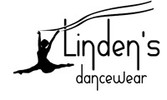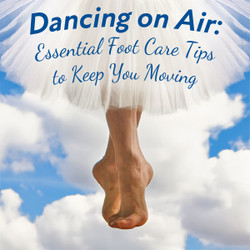Dancing on Air: Essential Foot Care Tips to Keep You Moving
Posted by Angel P. on 17th Jun 2025
Your feet are the unsung heroes of every dance performance. Whether you're leaping across the stage, performing intricate footwork, or executing a perfect pirouette, your feet endure tremendous pressure. Proper foot care isn't just about comfort—it's the foundation of injury prevention and peak performance for dancers.
Last year, we shared a blog post Dancer Foot Care for Happy Healthy Feet, and because this topic is so essential, we believe it's important to revisit and refresh it with updated information. Foot care needs can evolve with training intensity, seasons, and even trends in footwear or technique. From managing bunions to preventing blisters, keeping your feet healthy will ensure you stay strong on your toes—literally!
We understand the importance of maintaining foot health for dancers at all levels. Here’s everything you need to know about foot care—plus expert tips, stretches, and our favorite products—to help your feet feel and perform their best.
Why Foot Care is Crucial for Dancers
Dancers spend countless hours on their feet, which makes them more vulnerable to foot injuries compared to the general population. The repetitive movements, constant pressure, and friction from footwear all take a toll on your feet. Common foot issues for dancers include blisters, bunions, toenail problems, and foot fatigue.
Taking a proactive approach to foot care can help you avoid these issues and keep you dancing at your best. By incorporating preventative measures like proper alignment, using the right products, and performing targeted stretches, you can maintain healthy feet and avoid the discomfort that hinders your performance.
Preventing and Treating Blisters: Quick Action Makes a Difference
Blisters are among the most common foot injuries for dancers. Whether you’re dancing barefoot or in tight shoes, blisters can form due to friction or pressure points. Acting quickly is essential to prevent blisters from worsening. Here’s how you can protect your feet:
Blister Prevention Tips for Dancers:
- Taping:
Elastic medical tape, such as Bloch Toe Tape, is perfect for preventing blisters. Tape areas prone to friction before you start dancing, especially if you feel irritation developing. Taping forms a protective barrier, reducing the chance of a blister forming. - Foot Powder:
Foot powder helps keep your feet dry and reduces moisture that can lead to chafing and blister formation. Lightly dust your feet with foot powder before putting on shoes, especially for high-impact movement or shoes you wear barefoot without socks or tights. - Blister Stick:
Blister sticks are a barrier to the rubbing that causes blisters and chafing. Sweat and water-resistant, blister sticks create an invisible, non-greasy barrier on the skin that significantly reduces friction and rubbing, preventing blisters from forming. - Lamb’s Wool:
Lamb’s wool is an excellent cushioning material that can reduce friction and protect sensitive areas of your feet. Place small pieces over spots like the back of your heel or toes where blisters are most likely to form.
Treating Blisters:
If a blister does pop, proper care is essential to avoid infection:
- Avoid Draining Blisters:
Although it might be tempting, don’t drain a blister. The skin covering it provides a natural barrier against infection. If it bursts, clean it gently with antiseptic and cover it with a sterile bandage. - Blister Pads:
Blister bandages are typically hydrocolloid and work by creating a moist, protective, gel-like environment over the blister that absorbs fluid, cushions the area from further friction, and promotes faster, pain-free healing. - Dancer’s Dots:
Dancer’s Dots Protective Gel Cushions are perfect for protecting sore spots and blisters. These gel cushions soothe and reduce irritation, allowing you to continue dancing comfortably.
Managing Bunions: Prevent Pain and Improve Alignment
Bunions are occasional among dancers and are often hereditary, but not always! Poor technique, pronation (‘rolling- in’), or excessive pressure on the big toe from tight shoes can create or exacerbate the bunion problems. Here's how to manage and reduce bunion pain:
Bunion Prevention Tips:
- Toe Spacers:
Using toe spacers can help align the big toe joint and reduce pressure, alleviating bunion pain. This simple tool helps maintain neutral alignment and prevent worsening of the condition. - Correct Foot Alignment:
Focus on proper alignment during your daily movements and dance practice. Work on keeping your toes straight and aligned with pre-pointe resistance band exercises. When not dancing, focus on walking with your feet in parallel to minimize strain on your big toe joint.
Bunion-Aider: A Nighttime Solution:
For dancers experiencing pain from the early stages of bunion development, the Bunion-Aider device is a game-changer. Worn at night, it gently stretches and realigns the big toe to reduce the progression of bunions over time.
Preventing Toenail Issues: Healthy Toenails = Healthy Feet
In addition to blisters and bunions, dancers must be mindful of toenail health and maintain them regularly. In-grown toenails and bruised toenails are common issues, but with proper and consistent care, you can prevent them from disrupting your performance.
Preventing In-Grown Toenails:
- File, Don’t Clip:
Clipping toenails can cause them to grow incorrectly. Instead, file your nails gently to follow the natural curve of your toe. This reduces the risk of cutting your nails uncomfortably short and prevents the nails digging into the skin and causing painful in-grown toenails.
Preventing Bruised Toenails:
Bruised toenails are often caused by ill-fitting shoes, improper toe care, or constant pressure on the toes. To prevent bruising:
- Ensure your toenails are filed short enough! If your nail extends past the tip of the toe, it will be the first thing to hit your shoe creating pressure and leading to a damaged nailbed.
- Make sure your shoes fit properly, especially in the toe box area.
- Sneakers should have ample space for your toes.
- Ballet and Jazz shoes should be snug and form to the shape of your foot.
- Pointe Shoes must be expertly fitted to support you and prevent you from ‘sinking’ which puts excessive pressure on your toes.
- Use cushioned Bloch Toe Tape for added protection if you experience any toe discomfort and identify the cause so the issue doesn’t become chronic.
Soothing Foot Bath:
Soaking your feet in warm water with Epsom salts can relieve inflammation and soothe sore toes. It’s an excellent remedy for in-grown toenails or general discomfort after a long day of dancing.
Essential Foot and Toe Stretches for Dancers
A proper stretching routine is crucial for maintaining foot flexibility, strength, and alignment. Regular stretching can also prevent injuries and alleviate foot fatigue. Here are some essential foot stretches to incorporate into your routine:
- Toe Pulls:
Sit on the floor with your legs extended. Gently pull your toes toward your body, either one at a time or all together. This stretches the muscles in your feet and increases flexibility. Do 10–15 repetitions for optimal results. - Relevé Stretch:
Perform a relevé by rising onto your toes, then arch over your toes into a plié (bend your knees). Keep your toes long and straight as you stretch. This move strengthens and stretches your feet simultaneously. - Foot Cupping:
Sit or stand and gently lift your foot’s arch by cupping it with your hand. Hold for a few seconds, then relax. Repeat 20–30 times to build strength and stability in your foot’s ligaments. - Exercise Band Foot Work:
Using an exercise band around your foot, perform slow, controlled winging motions to strengthen your foot’s flexibility. Do 100 repetitions for improved arch support. - Towel Grabs:
Place a towel on the floor in front of you and use your toes to grab and lift it. Repeat for 20–30 reps to increase toe dexterity and strengthen your foot muscles.
Relieving Toe Cramps and Foot Fatigue
Toe cramps are common for dancers, especially after intense rehearsals. Regular foot massages and stretching devices can help alleviate these cramps and reduce muscle tension.
Self Myofascial Release (a.k.a. Foot massage):
Giving yourself a brief 5-10 minute foot massage, easily done while relaxing, can significantly help to soothe overstressed foot muscles. Focus on the soles, arches, and toes to relieve tightness and improve circulation. While this won't fully restore foot function on its own, it will help relax your overstressed feet. Alternatively, rolling a massage ball under each foot for two minutes daily is an effective way to relax and release tension.
YogaToes:
YogaToes are excellent for stretching the toes and relieving cramps. These devices help realign the toe joints and alleviate foot tension, providing relief from foot fatigue.
Still cramping? Consider Incorporating Electrolytes:
Electrolytes are vital minerals that help regulate muscle contractions and nerve impulses. Replenishing them, especially after intense exercise and sweating, can help prevent or alleviate muscle cramps by maintaining proper fluid balance and muscle function.
Keep Your Feet Healthy: Products and Tools
We’re committed to supporting dancers with top-quality foot care products. We have everything you need to keep your feet in peak condition. Shop our collection today:
Final Thoughts: Take Care of Your Feet... They’ll Take Care of You
Visit Linden’s Dancewear for expert advice and the finest foot care products to keep your feet healthy and happy. Schedule a Pointe Shoe Fitting with our Pointe Shoe Expert today to ensure you're getting the proper support and care for your feet. Your foundation as a dancer starts from the ground up—so take care of your feet, and they'll support you every step of the way!







